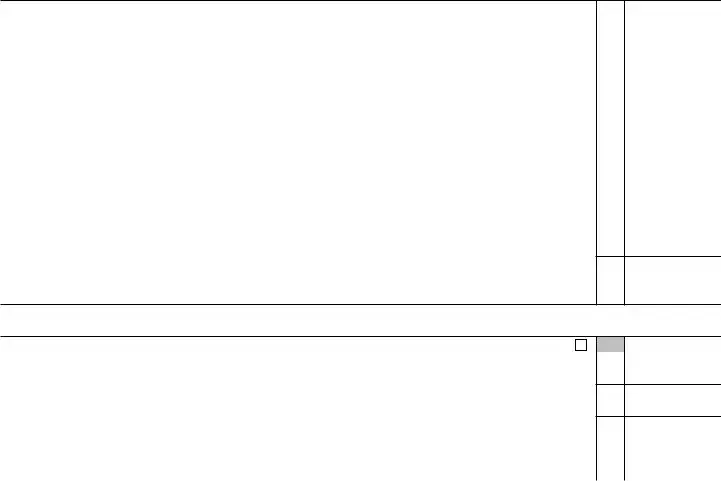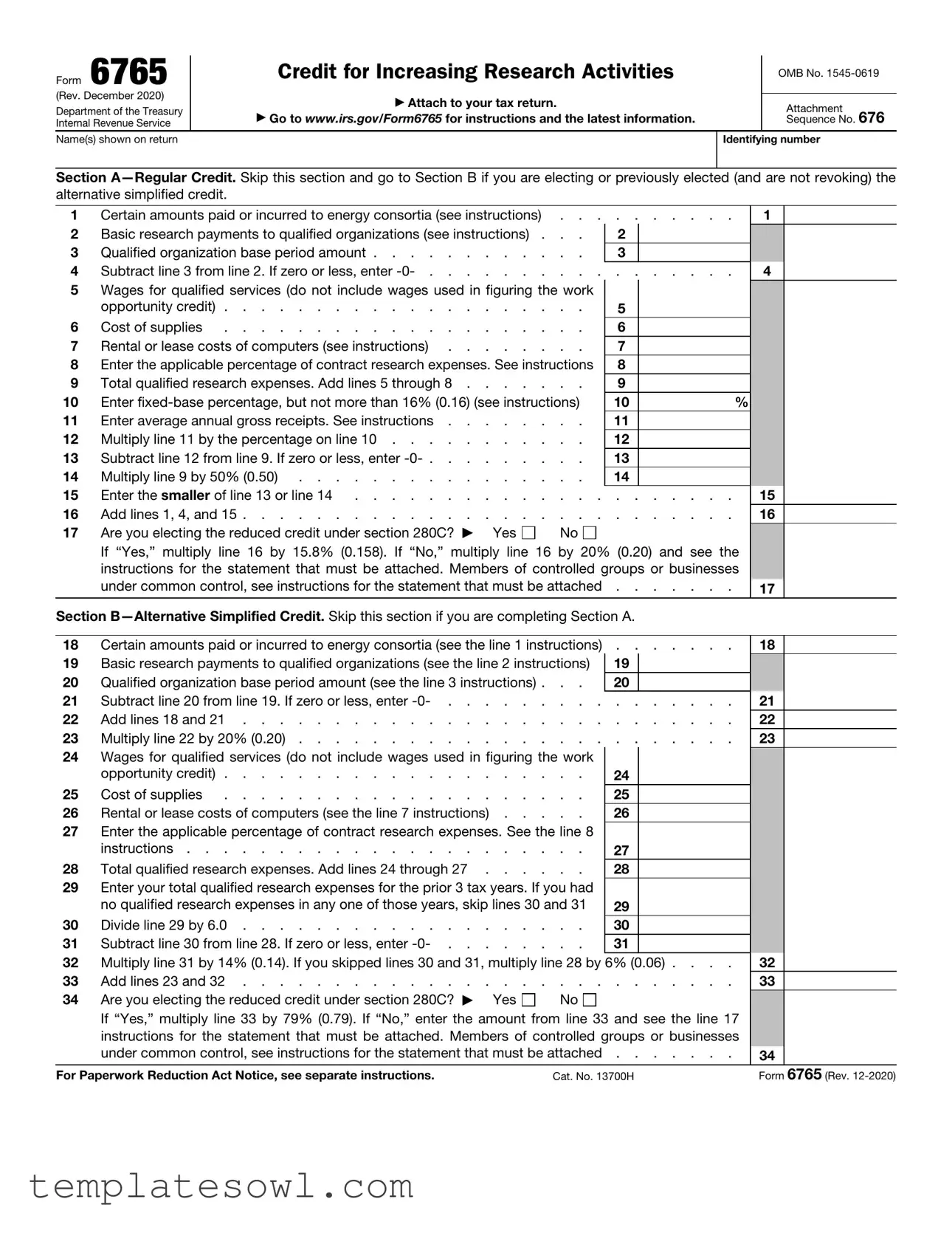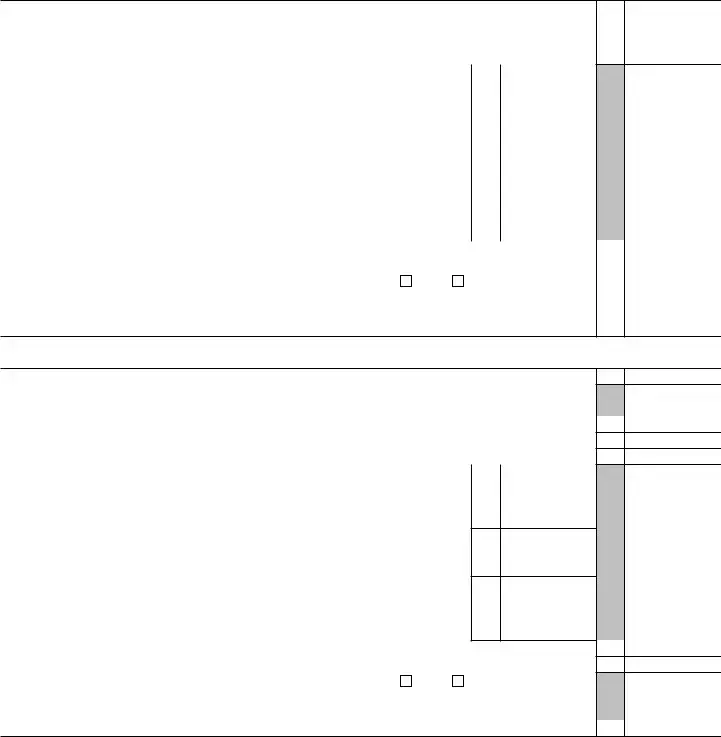
Form 6765 |
Credit for Increasing Research Activities |
|
OMB No. 1545-0619 |
|
|
|
(Rev. December 2020) |
▶ Attach to your tax return. |
|
|
|
Attachment |
Department of the Treasury |
|
▶ Go to WWW.IRS.GOV/FORM6765 for instructions and the latest information. |
|
Sequence No. 676 |
Internal Revenue Service |
|
|
|
|
Name(s) shown on return |
|
Identifying number |
|
|
|
|
Section A—Regular Credit. Skip this section and go to Section B if you are electing or previously elected (and are not revoking) the alternative simplified credit.
1 |
Certain amounts paid or incurred to energy consortia (see instructions) . . |
. . . . . . . . |
1 |
|
2 |
Basic research payments to qualified organizations (see instructions) . . . |
|
2 |
|
|
|
3 |
Qualified organization base period amount |
|
3 |
|
|
|
4 |
Subtract line 3 from line 2. If zero or less, enter -0- |
. . . . . . . . |
4 |
|
5Wages for qualified services (do not include wages used in figuring the work
|
opportunity credit) |
5 |
|
|
|
|
6 |
Cost of supplies |
6 |
|
|
|
|
7 |
Rental or lease costs of computers (see instructions) |
7 |
|
|
|
|
8 |
Enter the applicable percentage of contract research expenses. See instructions |
8 |
|
|
|
|
9 |
Total qualified research expenses. Add lines 5 through 8 |
9 |
|
|
|
|
10 |
Enter fixed-base percentage, but not more than 16% (0.16) (see instructions) |
10 |
% |
|
|
|
11 |
Enter average annual gross receipts. See instructions |
11 |
|
|
|
|
12 |
Multiply line 11 by the percentage on line 10 |
12 |
|
|
|
|
13 |
Subtract line 12 from line 9. If zero or less, enter -0- |
13 |
|
|
|
|
14 |
Multiply line 9 by 50% (0.50) |
14 |
|
|
|
|
15 |
Enter the smaller of line 13 or line 14 |
. . . |
. . . . |
|
15 |
|
16 |
Add lines 1, 4, and 15 |
. . . |
. . . . |
|
16 |
|
17 |
Are you electing the reduced credit under section 280C? ▶ Yes |
No |
|
|
|
|
|
|
If “Yes,” multiply line 16 by 15.8% (0.158). If “No,” multiply line 16 by 20% (0.20) and see the |
|
|
|
instructions for the statement that must be attached. Members of controlled groups or businesses |
|
|
|
under common control, see instructions for the statement that must be attached |
. . . |
. . . . |
|
17 |
|
Section B—Alternative Simplified Credit. Skip this section if you are completing Section A.
18 |
Certain amounts paid or incurred to energy consortia (see the line 1 instructions) |
19 |
Basic research payments to qualified organizations (see the line 2 instructions) |
19 |
|
20 |
Qualified organization base period amount (see the line 3 instructions) . . . |
20 |
|
21 |
Subtract line 20 from line 19. If zero or less, enter -0- |
22 |
Add lines 18 and 21 |
23 |
Multiply line 22 by 20% (0.20) |
24Wages for qualified services (do not include wages used in figuring the work
|
opportunity credit) |
24 |
25 |
Cost of supplies |
25 |
26 |
Rental or lease costs of computers (see the line 7 instructions) |
26 |
27Enter the applicable percentage of contract research expenses. See the line 8
instructions |
27 |
28 Total qualified research expenses. Add lines 24 through 27 |
28 |
29Enter your total qualified research expenses for the prior 3 tax years. If you had
|
no qualified research expenses in any one of those years, skip lines 30 and 31 |
29 |
30 |
Divide line 29 by 6.0 |
30 |
31 |
Subtract line 30 from line 28. If zero or less, enter -0- |
31 |
32Multiply line 31 by 14% (0.14). If you skipped lines 30 and 31, multiply line 28 by 6% (0.06) . . . .
33 |
Add lines 23 and 32 |
34 |
Are you electing the reduced credit under section 280C? ▶ Yes |
No |
If “Yes,” multiply line 33 by 79% (0.79). If “No,” enter the amount from line 33 and see the line 17 instructions for the statement that must be attached. Members of controlled groups or businesses under common control, see instructions for the statement that must be attached . . . . . . .
For Paperwork Reduction Act Notice, see separate instructions. |
Cat. No. 13700H |
Form 6765 (Rev. 12-2020) |
Form 6765 (Rev. 12-2020) |
Page 2 |
|
|
Section C—Current Year Credit
35Enter the portion of the credit from Form 8932, line 2, that is attributable to wages that were also
|
used to figure the credit on line 17 or line 34 (whichever applies) |
35 |
|
36 |
Subtract line 35 from line 17 or line 34 (whichever applies). If zero or less, enter -0- |
36 |
|
37 |
Credit for increasing research activities from partnerships, S corporations, estates, and trusts . . . |
37 |
|
38 |
Add lines 36 and 37 |
38 |
|
|
• Estates and trusts, go to line 39. |
|
|
|
• Partnerships and S corporations not electing the payroll tax credit, stop here and report this amount on |
|
|
|
Schedule K. |
|
|
|
• Partnerships and S corporations electing the payroll tax credit, complete Section D and report on |
|
|
|
Schedule K the amount on this line reduced by the amount on line 44. |
|
|
|
• Eligible small businesses, stop here and report the credit on Form 3800, Part III, line 4i. See instructions |
|
|
|
for the definition of eligible small business. |
|
|
|
• Filers other than eligible small businesses, stop here and report the credit on Form 3800, Part III, line 1c. |
|
|
|
Note: Qualified small business filers, other than partnerships and S corporations, electing the payroll tax |
|
|
|
credit must complete Form 3800 before completing Section D. |
|
|
39 |
Amount allocated to beneficiaries of the estate or trust (see instructions) |
39 |
|
40Estates and trusts, subtract line 39 from line 38. For eligible small businesses, report the credit on Form 3800, Part III, line 4i. See instructions. For filers other than eligible small businesses, report the
credit on Form 3800, Part III, line 1c |
40 |
Section D—Qualified Small Business Payroll Tax Election and Payroll Tax Credit. Skip this section if the payroll tax election does not apply. See instructions.
41 Check this box if you are a qualified small business electing the payroll tax credit. See instructions
42Enter the portion of line 36 elected as a payroll tax credit (do not enter more than $250,000). See
43General business credit carryforward from the current year (see instructions). Partnerships and S
corporations, skip this line and go to line 44 |
43 |
44Partnerships and S corporations, enter the smaller of line 36 or line 42. All others, enter the smallest of line 36, line 42, or line 43. Enter here and on the applicable line of Form 8974, Part 1, column (e). Members of controlled groups or businesses under common control, see instructions for the statement
that must be attached |
44 |
|
Form 6765 (Rev. 12-2020) |


